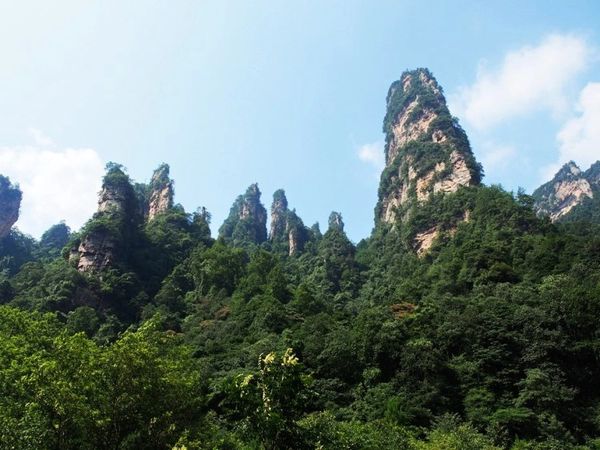Zhangjiajie National Forest Park Tour from Shanghai or Beijing
How to get to Zhangjiajie from Shanghai or Beijing
The core scenic area of Zhangjiajie is Wulingyuan Scenic and Historic Interest Area, and generally speaking, Zhangjiajie tourism is mainly to visit Wulingyuan. Zhangjiajie, Suoxiyu, Tianzi Mountain three scenic areas named "Wulingyuan". Therefore, Wulingyuan Scenic Area is composed of Zhangjiajie National Forest Park, Tianzi Mountain Nature Reserve, Suoxiyu Nature Reserve, Yangjiajie National Forest Park, Suoxiyu Nature Reserve, Yangjiajie National Park, Suoxiyu Nature Reserve, and Zhangjiajie National Park. The park is made up of nature reserves, and the city is also famous for the Tianmen Mountain National Forest Park.
The Tianmen Mountain National Forest Park, with its thrilling glass boardwalk and the magical Tianmen Cave, has always been a popular tourist attraction and is known as the "New Legend of Zhangjiajie".
To travel from Beijing or Zhangjiajie, the best way is to fly due to the long distance. The flight time is 2 hours and 20 minutes from Shanghai and 3 hours from Beijing. The flight from Shanghai costs usually half of the flight from Beijing. Traveling from Shanghai does save.
5-Day Tour Zhangjiajie from Shanghai or Beijing
A tour that covers both the Zhangjie mountains and the Phoenix City
Day 1: Arrive from Shanghai or Beijing. Airport transfer.
Day 2: Today we will be making an excursion to the ancient town of Fenghuang (Phoenix City) along the Mengdong River. Major scenic spots include Eight-Scene Cave, Small Dragon Cave,natural cliff side murals, Golden-Star Gorge, Fairy Gorge ,Line of Sky, Jumping Monkey, Yuanyang Gorge and Laojun Gorge. You can enjoy rafting on the Si River, a tributary of the Mengdong. The river flows along a narrow valley and the water is swift. It is a great adventure to drift on it. Along the way we will also stop at the town of Furong. Most of the people there are of the Tujia Minority group.
Fenghuang, praised as "the Most Beautiful Town of China" by famous New Zealand writer Rewi Alley, is a small county renowned for its natural beauty, rich history and culture as well as its colorful ethnic customs.
Day 3: Today, we'll examine the architectural marvels of the Tujia people’s Diaojiaolou (stilted house), which are prevalent throughout the town. This stilted house has its own ethnic distinctiveness; for, it is constructed in such a way as to overhang the water and be supported by many wooden pillars. According to tradition, the specific reason for building such a structure is to deliver the inhabitants from miasma, poisonous vegetation and venomous snakes. Aside from this, Tujia people are accustomed to constructing their houses over the water and in proximity to the mountains, with most residences established in the valleys, giving the appearance of crouching tigers. Over several millennia, a simple shelter against wind and rain has evolved into a construction, which is practical, graceful and artistic, harmonizing with the surrounding natural environment. Lodge in Zhangjiajie.
Day 4: A full-day excursion to Zhangjiajie National Forest Park. The park was first established by the state council in 1982 as the 1st national forest park of China. Covering 13 sq km, the park is known for it's unique landscape with lush forests dominated by quartzite sandstone pillars. Bubbling brooks and charming lakes wind around the area and connect giant caves. One of China's most beautiful nature reserves, Zhangjiajie has wonderful hiking trails in a serene environment of staggering natural beauty. Stay in a guest house in the park.
Day 5: A full-day to tour Tianzi Mountain Nature Reserve and Yellow Dragon Covern.
The Tianzi Mountain is a mesa in the northwest of Wulingyuan. Up on the mesa, the field of vision is widely opened up and it is a perfect location to have a panoramic view of the nature reserve. Tianzi Mountain has four scenic wonders, namely Cloud Billows, Moon Brightness, Sun Glow and Winter Snow. The cloud billows are ever changing, morning and evening sun glows vast sky, moon shines in the still night, winter snow falls enchanting the scenery, like a lyric, like a landscape painting. Here in the Tianzi Mountain, scene majestic is in all its variety. There are five main scenic zones and over ten scenic spots in the Tianzi Mountain area.
Yellow Dragon Cavern is a typical Karst cave, an area of irregular limestone in which erosion has produced fissures, underground streams, and caverns.
Airport transfer in the late afternoon.
Included
1. Hotels with daily western breakfasts;
2. Meals in accordance with that listed on the itinerary.
3. Professional English-speaking local guide & driver;
4. Private air-conditioned car or van for transportation;
5. General admissions
Zhangjiajie from Shanghai and Beijing
Zhangjiajie and Fenghuang Impression











































REQUEST A TOUR
Copyright © 2003-2026 Great Wall Adventure Club - All Rights Reserved.
Speical Offer for Expats
Save up to 20% of your spring and summer tours. Expats can WeChat us #GWAC2015 for easy booking.
This website uses cookies.
We use cookies to analyze website traffic and optimize your website experience. By accepting our use of cookies, your data will be aggregated with all other user data.